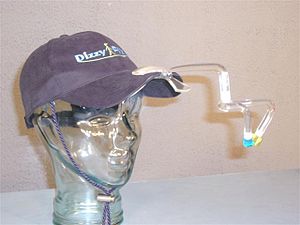- DizzyFIX
-
The DizzyFIX is an FDA cleared home medical device available to assist in the treatment of Benign Paroxysmal Positional Vertigo (BPPV) and its associated vertigo.[1] The device itself is a head-worn representation of semi-circular canals. The device is filled with fluid and a particle representing the otoconia (loose hard particles) associated with BPPV. The device works like a visual set of instructions and guides the user through the treatment maneuver for BPPV. This maneuver is called the particle repositioning maneuver or Epley maneuver.
Contents
BPPV
Main article: BPPV Nystagmus.
Nystagmus.
BPPV is the most common cause of peripheral vertigo.[2] It can be characterized by three main symptoms: positional onset, spinning dizziness and short lived symptoms. The primary diagnostic maneuver is the Dix-Hallpike which elicits the cardinal sign associated with BPPV, rotatory nystagmus.
Background
The DizzyFIX was originally developed by otolaryngologists (ENT physicians) to assist in the long term treatment of patients with a known history of recurrent BPPV.[3] BPPV is frequently highly recurrent with rates as high as 50%.[4] Radtke et al. have suggested that home treatment is both safe and effective when training is adequate but that the key cause of failure of the home treatment is an imperfect repositioning maneuver.[5] As a result of failed home treatments the DizzyFIX was developed to assist patients in the performance of a correct particle repositioning maneuver. Research to date indicates that use of the device is correlated with a correct particle repositioning maneuver (Beyea, 2007).
The device was subsequently manufactured by Clearwater Clinical of Calgary, Alberta and further research was undertaken at the University of Western Ontario, London, Ontario.
Global News reported on the DizzyFIX on April 2, 2009. (YouTube Video)
On May 19, 2010 The Discovery channel conducted an interview dealing with the DizzyFIX device and an iPhone app which can help doctors perform the maneuver more easily. (Discovery Channel Video Clip)
Research
Bromwich et al. measured the impact that DizzyFIX had on volunteers' ability to perform the Epley maneuver. Reports indicated that the DizzyFIX improves accuracy by comparison to instructions and expert training alone. The design and development of the device is also described.[6]
Beyea et al. used the DizzyFIX as an objective measure of a various methods of medical education. DizzyFIX outcome was compared with objective observers of participants performance.[1]
Research dealing with the design and clinical application of the device was published in the July edition of Archives of Otolaryngology. The researchers gave the DizzyFIX to 40 patients suffering from BPPV. After one week of home treatment, 35 patients (88 percent) had no evidence of BPPV.[7]
Device certification
- The DizzyFIX is FDA cleared for use in the USA.(K081602)
- The DizzyFIX is CE registered in the European Union.
- The DizzyFIX device is a Class I medical device according to Rule 7(1) of the Medical Devices Regulations and has been reviewed and determined to be such by the Device Licensing section of the Medical Devices Bureau of Health Canada.
- The DizzyFIX complies with Canada's Medical Devices Regulations, which include: safety and effectiveness (Sections 10 to 20, 21 to 23, 52 to 58, 59 to 62, and 63 to 65). It also complies with the requirements of Sections 3 and 19 to 21 of Canada's Food and Drugs Act.
See also
References
- ^ a b Beyea J, Wong E, Bromwich M, Weston W, Fung K. (2007). "Evaluation of a Particle Repositioning Maneuver Web-Based Teaching Modudle Using the DizzyFIX". Laryngoscope 117:.
- ^ Nedzelski JM, Barber HO, McIlmoyl L. (1986). "Diagnoses in a dizziness unit.". J Otolaryngol 15 (2).
- ^ Clearwater Clinical. www.dizzyfix.com.
- ^ Nunez RA, Cass SP, Furman JM. (2000). "Short- and long-term outcomes of canalith repositioning for benign paroxysmal positional vertigo". Otolaryngol Head Neck Surg 122 (5): 647–52. doi:10.1016/S0194-5998(00)70190-2. PMID 10793340.
- ^ Radtke A, von BM, Tiel-Wilck K, Mainz-Perchalla A, Neuhauser H, Lempert T. (2004). "Self-treatment of benign paroxysmal positional vertigo: Semont maneuver vs Epley procedure". Neurology 63 (1).
- ^ Bromwich MA, Parnes LS. (2008). "The DizzyFix: Initial Results of a New Dynamic Visual Device for the Home Treatment of Benign Paroxysmal Positional Vertigo". J Otolaryngol 37(3):.
- ^ Bromwich M, Hughes B, Raymond M, Sukerman S, Parnes L. (2010). "Efficacy of a new home treatment device for benign paroxysmal positional vertigo". Archives of Otolaryngology 136:.
External links
- DizzyFIX Home treatment device
- Feature Article - Calgary Herald "Fixing the Dizzies - Michelle Magnan"
- Feature Article - Reuters Device combats common cause of vertigo
- University of Western Ontario
- Clearwater Clinical Limited Medical Technology
- Dizzytimes.com Online Community for Sufferers of Vertigo and Dizziness
- DizzyFIX in the UK BPPV & how the device can help
Categories:
Wikimedia Foundation. 2010.

